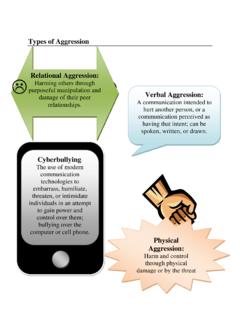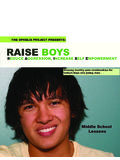Transcription of Grades 9 12 - Leading Resource On Relational …
1 Grades 9-12 2011 The Ophelia Project All Rights Reserved. CYBERCOOL 15 positively powerful lessons to teach digital citizenship and stop cyberbullying Grades 9-12 2011 The Ophelia Project All Rights Reserved. CyberCool Grades 9-12 1 Table of Contents Why Address Cyberbullying? .. 3 Essential Questions and Curriculum Objectives .. 5 How to Use This Curriculum .. 6 CORE CONCEPT ONE: Peer Aggression .. 9 LESSON ONE: Types of Aggression .. 10 LESSON TWO: Proactive vs. Reactive Aggression .. 12 LESSON THREE: Online vs. Real Life .. 14 CORE CONCEPT TWO: Communication.
2 16 LESSON FOUR: Online 17 LESSON FIVE: Text, Tweet, Poke, and Post .. 20 CORE CONCEPT THREE: Anonymity .. 23 LESSON SIX: Anonymity and Empathy .. 24 LESSON SEVEN: When Does Cyberbullying End? .. 27 LESSON EIGHT: Cyberbullying Whodunnit .. 29 CORE CONCEPT FOUR: Empowerment .. 32 LESSON NINE: EMPOWERING CYBER-TARGETS AND BYSTANDERS .. 33 LESSON TEN: Making it Right for Cyber-Aggressors .. 36 CORE CONCEPT FIVE: Accountability .. 38 LESSON ELEVEN: Cyberbullying as a Crime .. 39 LESSON TWELVE: Sexting: Free Speech or Child Pornography .. 42 CORE CONCEPT SIX: Privacy .. 45 LESSON THIRTEEN: To Share or Not to Share.
3 46 LESSON FOURTEEN: The College/Job Search and Your Digital Footprint .. 49 Wrap Up Lesson: Digital Citizenship Campaign .. 52 Appendices .. 54 Appendix A: Peer Aggression Glossary .. 55 Appendix B: Curriculum Vocabulary .. 63 Appendix C: Teacher Resource Guide .. 65 Appendix D: Future of Education .. 68 Appendix E: National Standards .. 69 2011 The Ophelia Project All Rights Reserved. CyberCool Grades 9-12 2 Appendix F: Curriculum Case Summaries .. 72 Appendix G: Roles in Aggression .. 80 Appendix H: Aggression Venn Diagram .. 81 Appendix I: Sample SmartArt Flowchart .. 82 Appendix J: Guidelines for Internet Discussions.
4 83 Appendix K: Cyber Discussion Samples .. 84 Appendix L: Messages to Communicate .. 87 Appendix M: Aggressive Incident Examples .. 88 Appendix N: Sample Cyberbullying Reporting Protocol .. 90 Appendix O: Facebook Profile Information .. 91 Appendix P: Research Brief: Your Digital Footprint and Your Future .. 92 Appendix Q: Digital Citizenship Campaign Description .. 93 Appendix R: Digital Citizenship Campaign Rubric .. 94 2011 The Ophelia Project All Rights Reserved. CyberCool Grades 9-12 3 Why Address Cyberbullying? The Ophelia Project serves those who are affected by Relational aggression, which is defined as behavior that is intended to harm someone by damaging or manipulating her or his relationships with others.
5 Examples of Relational aggression include bullying, taunting, exclusion, gossip and cyberbullying, to name a few. The Ophelia Project operates under two guiding principles. While bullying and Relational aggression have been present in our society for a long time, we should never condone them as being part of the fabric of school life. Also, incidents of bullying and Relational aggression are increasing and those incidents are often more severe in nature. A survey conducted by the Stanford University School of Medicine and Lucile Packard Children s Hospital revealed that 9 out of 10 elementary students have been bullied by their peers, and nearly 6 out of 10 students reported participating in some type of bullying themselves.
6 The National Association of School Psychologists reports that 160,000 children miss school every day because they are afraid of being bullied. Many schools go to great lengths to protect their students from outside hazards by installing metal detectors and security systems, yet many students report that the things they fear the most are inside their schools. Students who feel unsafe emotionally are not available for learning. Research has shown that Relational aggression contributes to lower academic performance among students, as well as higher rates of school absenteeism, increased discipline problems, and higher reports of depression and other mental health issues.
7 Furthermore, recent studies have also linked Relational aggression with somatic complaints, such as headaches, stomachaches, fatigue, insomnia and loss of appetite (Austin & Joseph, 1996; Baumeister & Leary, 1995; Crick & Grotpeter, 1996; Dodge et al, 2003; Gilbert, 1992; Nixon, 2006; Parker & Asher, 1998; Patterson, Capaldi & Bank, 1991; Rigby, 1999). Cyberbullying, the newest form of Relational aggression, is the use of modern communication technologies (such as the Internet and cell phones) to embarrass, humiliate, threaten, or intimidate individuals in an attempt to gain power and control over them.
8 Examples of cyberbullying include creating forums for harassing an individual on a website, sending harassing, threatening messages via e-mail or Instant Message, digitally editing someone s image and posting it online to embarrass him or her, or spreading rumors on a social networking site. These are just a few examples of how modern technology can be used in relationally aggressive ways. 2011 The Ophelia Project All Rights Reserved. CyberCool Grades 9-12 4 Fight Crime: Invest in Kids estimates that more than 13 million children ages 6-17 have been victims of cyberbullying, yet less than 40% of victims surveyed reported the experience (Hinduja and Patchin, 2005).
9 Because this type of aggression is often anonymous, it is particularly hard to address. In addition, because the digital audience is so vast, damage to the target is much more extensive. Addressing cyberbullying comes up against a few very pervasive norms. According to a study by Sam McQuade at RIT, a majority of 17,000 students surveyed think that cyberbullying is not a deviant behavior; it is in fact a normal one. At The Ophelia Project, we challenge that belief to be a result of too little guidance for youth while exploring their online networks. New revelations about online privacy, digital footprinting, increasingly connected digital social networks, and a few high-profile cyberbullying cases have brought cyberbullying to the forefront of the efforts to protect young people online.
10 The Internet Safety Technical Task Force released a report in January 2009 that pointed to bullying and harassment by peers online as the most frequent threat to minors, both online and off. They suggest that parents, educators and other advocates for youth safety should become as educated as possible about the online behaviors of the children in their life and to be supportive of their digital connections. Both the MacArthur Foundation s Digital Media & Youth Project and the Partnership for 21st Century Skills acknowledge the fundamental necessity for young people to be engaged with technology for relationship and network development, creative and interest-driven research, and to develop critical information, media and technology literacies.

















